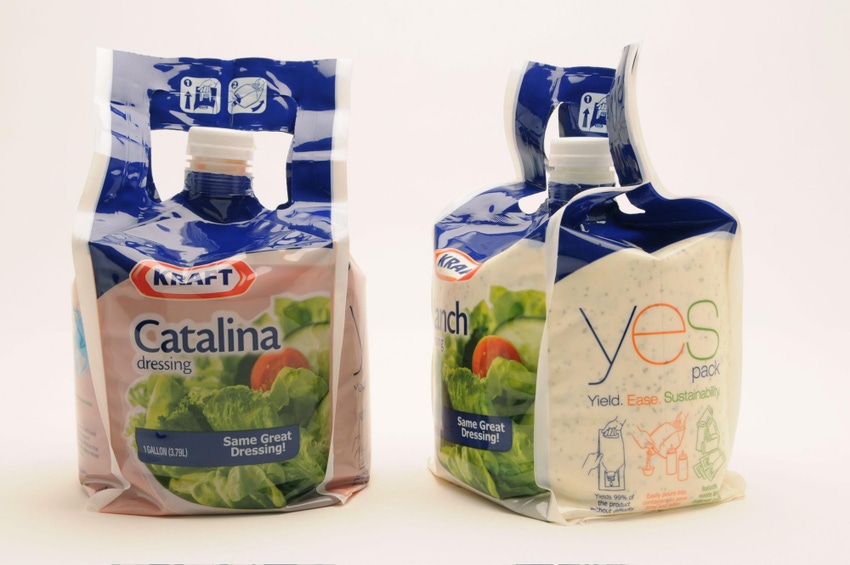Despite report, packaging innovation is alive and well
Earlier this year, a study from Visiongain stated that the food packaging market has reached a "plateau" in terms of technology and its ability to carry out its primary duty, which is that of protecting and extending the life of the foodstuffs within the packaging.
December 20, 2013

Earlier this year, a study from Visiongain stated that the food packaging market has reached a "plateau" in terms of technology and its ability to carry out its primary duty, which is that of protecting and extending the life of the foodstuffs within the packaging.The report predicts that the market growth will be neither slow nor excessive, with a balance offset by the slow growth in the more developed economies of the west with the promising economies of the east. As such, Visiongain has determined that the global food packaging market will attain sales of $251.8 billion in 2013.Sree Selvam, the materials analyst behind the global food packaging market report, told PlasticsToday that Visiongain consulted with industry experts and full transcripts from these exclusive interviews with We Are Pure, INCPEN and The Packaging Federation are included in the report.He said from their research, they found that while neither small nor big companies are investing much in innovation, smaller companies are especially hesitant."It tends to be that part of the market is very much a standstill for both the big and small boys," he said. "It comes down to a cost basis really, the margins are too small. We have seen a couple of the larger multinational companies afford to do it, but even bigger companies are cautious."Selvam said that many companies are focusing on branding rather than innovation."From an engineering standpoint for the next year and year and half, we see quite a standstill," he said. "The big thing at the moment is coming out with the same product, with a slight modification, that really catches the eye of the consumer rather than changing the structure of the package."The study brought up some interesting points and PlasticsToday reached out to Dow Chemical Co., UK-based Linpac Packaging and Octal get their viewpoint on packaging development. Innovation never stopsGreg Bunker, marketing manager, flexible food and specialty packaging at Dow, said that food packaging will never reach a "plateau." "There will never be a plateau in terms of innovation and the best reason for that is packaging is a consumer goods market, shaped by consumer preferences," he said. "Just like things come and go in style, you see the same thing with packaging. It's almost like telling a fashion designer style will never change, I doubt they would agree."It's no surprise that Bunker bristles at that idea that innovation is a standstill. After all, Dow launched 42 new products for the packaging sector in 2012. This equates to nearly one new product per week in the year.Scott Collick, TS&D director at Dow, said the company receives on average about two customers a week requesting new packaging innovation. These requests run the gamut from people looking into replacing cans with pouches to dropping glass in favor of flexible packaging.One example Collick cited was the aging population. For instance, many are requesting easy-to-open packaging as they currently struggle with opening lids or caps off of jars and other forms of packaging. Dow's Sealution peel polymers reportedly deliver consistent peel strength over time, enabling strong seal strength for package fillers (such as food companies) while making packages easier to open for consumers.Collick said that peel polymers can be applied to all types of food packaging such as cereal bags to fresh produce."No one likes a hard-to-open package," Collick said. "That is just an example of where consumers' frustration helped innovate."When it comes to launching new products, Bunker said the company spends plenty of time evaluating trends in each market and which material will best serve it."It's never been a more exciting time to be in packaging," he said. "Through the combination of sustainable awareness, fighting food waste and just recognizing that flexible is the best choice - make it an exciting time."For Collick, it comes down to a single premise."New humans arrive on the planet every day and getting food to those people is a critical mission," he said. "Packaging plays a vital role in ensuring that the food is safe and secure. With all the babies arriving each day, it calls for a lot of great innovation."3-5 year R&D planning windowWith innovation in her job title, Jo Stephenson, VP of marketing and innovation at UK-based Linpac Packaging, clearly believes innovation is prevalent in food packaging. "The development of technologies for the packaging market is accelerating all the time, so I would disagree very much so with the idea that we have reached a plateau," she said. "At Linpac Packaging, we are working on new polymer technologies to develop extended barrier (shelf life) performance of packs in flexible and rigid plastics and we are utilizing new antimicrobial additives to improve hygiene and safety in protein packaging applications."Stephenson said that the company is looking at the modification of existing polymers to improve functionality. For example, Linpac is investing in scientific research and development projects that look at increasing the temperature resistance of current polymers to extend their use into microwave and oven pack applications.Still, Stephenson acknowledged that one could argue that, in terms of fundamental packaging developments, the 'low hanging fruit' has been reached. "However, materials science and new technologies being brought into the packaging world, such as the application of plasma treatments, new print software technologies, etc., will continue to ramp the pace of change well into the next few
"There will never be a plateau in terms of innovation and the best reason for that is packaging is a consumer goods market, shaped by consumer preferences," he said. "Just like things come and go in style, you see the same thing with packaging. It's almost like telling a fashion designer style will never change, I doubt they would agree."It's no surprise that Bunker bristles at that idea that innovation is a standstill. After all, Dow launched 42 new products for the packaging sector in 2012. This equates to nearly one new product per week in the year.Scott Collick, TS&D director at Dow, said the company receives on average about two customers a week requesting new packaging innovation. These requests run the gamut from people looking into replacing cans with pouches to dropping glass in favor of flexible packaging.One example Collick cited was the aging population. For instance, many are requesting easy-to-open packaging as they currently struggle with opening lids or caps off of jars and other forms of packaging. Dow's Sealution peel polymers reportedly deliver consistent peel strength over time, enabling strong seal strength for package fillers (such as food companies) while making packages easier to open for consumers.Collick said that peel polymers can be applied to all types of food packaging such as cereal bags to fresh produce."No one likes a hard-to-open package," Collick said. "That is just an example of where consumers' frustration helped innovate."When it comes to launching new products, Bunker said the company spends plenty of time evaluating trends in each market and which material will best serve it."It's never been a more exciting time to be in packaging," he said. "Through the combination of sustainable awareness, fighting food waste and just recognizing that flexible is the best choice - make it an exciting time."For Collick, it comes down to a single premise."New humans arrive on the planet every day and getting food to those people is a critical mission," he said. "Packaging plays a vital role in ensuring that the food is safe and secure. With all the babies arriving each day, it calls for a lot of great innovation."3-5 year R&D planning windowWith innovation in her job title, Jo Stephenson, VP of marketing and innovation at UK-based Linpac Packaging, clearly believes innovation is prevalent in food packaging. "The development of technologies for the packaging market is accelerating all the time, so I would disagree very much so with the idea that we have reached a plateau," she said. "At Linpac Packaging, we are working on new polymer technologies to develop extended barrier (shelf life) performance of packs in flexible and rigid plastics and we are utilizing new antimicrobial additives to improve hygiene and safety in protein packaging applications."Stephenson said that the company is looking at the modification of existing polymers to improve functionality. For example, Linpac is investing in scientific research and development projects that look at increasing the temperature resistance of current polymers to extend their use into microwave and oven pack applications.Still, Stephenson acknowledged that one could argue that, in terms of fundamental packaging developments, the 'low hanging fruit' has been reached. "However, materials science and new technologies being brought into the packaging world, such as the application of plasma treatments, new print software technologies, etc., will continue to ramp the pace of change well into the next few decades," she said.From an R&D perspective, Linpac works across a number of fronts to make sure it remains in touch with the latest trends and consumer needs. The company conducts consumer studies on a regular basis to further its understanding of what drives consumer demand. "We work with partners across our industry - packers, fillers, machine suppliers, label companies- to understand the latest trends in their technologies and ensure our packs meet their efficiency needs," she said. "Finally, we work with key industry trade associations and NGOs to further our understanding of issues such as food waste, recycling, and the latest legislative changes which, again, drive our research and development processes."Linpac Packaging works on a 3-5 year R&D planning window using a typical stage gate structure to manage its project priorities.One example of a new innovation from Linpac includes its Rfresh Elite, a patented approach to ensuring the recyclability of rigid plastic packaging trays in Europe.Stephenson said the key challenge for rigid rPET trays today is the incorporation of a laminated PE base film, which is included to facilitate the heat sealing of PE lidding films to the trays. Linpac has developed a patented flange sealing system that enables the elimination of this base film lamination step, removing 3% weight from the tray, reducing its carbon footprint, and enabling recyclability.Another area where Stephenson sees innovation in food packaging is the usage of nanotechnology."While there are still concerns about the degree to which nanomaterials can leach into food from the packaging, and the effect they may have on the health of consumers, most research so far looks promising, and the benefits are highly tangible," she said. "Several nano-enhancements for packaging are already on the market, helping to prolong the shelf life of food and making it easier to manufacture, process, and manage."For some time now, food has been packaged in a protective, oxygen-free atmosphere. Standard packing film made from flexible plastics, however, is slightly permeable to oxygen and other gases. Over time, this means that the protective atmosphere can leak out, and oxygen can leak in, damaging the food.A coating of metal or glass, which are totally impermeable to gases, would prevent this from happening. But Stephenson said this is impractical as it would reduce flexibility, and would be much more expensive than plastic packaging."This is where nanotechnology comes to the rescue - a coating just a few nanometers thick is sufficient to create an impermeable layer, without compromising on flexibility or adding a great deal to the cost," she said.Innovation makes business senseOctal Chief Operating Officer Joe Barenberg said that anytime you have a free market, suppliers are competing to serve the needs of their customer base. A clear cut competitive advantage is innovation."We don't believe innovation has reached a plateau, there's always room to get something better than it currently is," he said. "Think about computers when the first calculator came out, certainly those same people would be flabbergasted that we can do it with a smartphone. I think innovation will always have a place."
Innovation is something that the clear rigid food packaging materials supplier prides itself on. In 2008, Octal introduced its direct-to-sheet PET product, DPET, which is produced with what the company says is "the smallest carbon footprint of any PET product in the world." Octal's proprietary process enables it to produce high quality DPET with 67% less energy, fewer machines, and a shorter manufacturing period when compared to conventionally produced PET. The company's direct-to-sheet process eliminates five stages of the conventional sheet making process, which includes pelletzing and drying.The market has responded, with Octal reporting sales reaching $1.5 billion.Barenberg said innovation isn't only about product development. He said Octal was founded on the idea that it could build a better company that produces a better product, but at the same time, is also better for the environment.For example, the petrochemicals used to make DPET are transported through an underground pipeline, which reduces the emissions that would be required to ship the petrochemicals via truck or rail line. The proximity of the plant to the Indian Ocean means that Octal's products can be shipped primarily via sea freight, which further reduces emissions. Further, the company said that 70% of DPET is shipped pallet-less, maximizing the amount of PET product per shipment and therefore reducing the number of trips and weight of each load."There are so many stories of companies making great inventions that really took the world by storm for a period of time," he said. "But if we don't continue to evolve, our competitors will certainly do so. Great companies are thinking about the next thing to drive growth and reward shareholders and customers with a better product. I don't think there is an industry out there that doesn't have someone who doesn't want to innovate whether in its product or service platform."
About the Author(s)
You May Also Like


